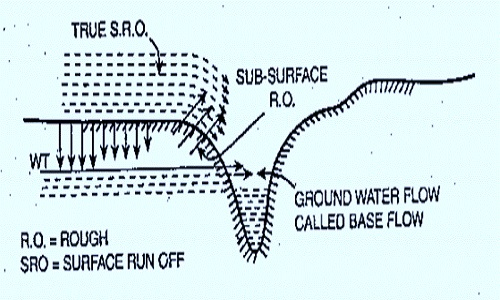Table of Contents
Runoff Definition:
Runoff includes all the water flowing in the stream channel at any given time. It is expressed in terms of m3/s or m3/h.
Runoff = Surface runoff + Base Flow
Difference Between Runoff And Surface Runoff?
Runoff includes all the water flowing in the stream channel at any given time.
Surface runoff includes only the water which reaches the stream channel without seeping into the ground.

Types Of Runoff?
Runoff is classified into three types:
- Surface Runoff
- Subsurface Runoff
- Base Runoff
Here is the complete description of these three types of runoff.
1. Surface Runoff:
When the water after precipitation merges with the stream then it is known as surface runoff. It occurs when all loss is satisfied, rainfall is continued and the rate of rainfall (intensity) is greater than the infiltration rate.
2. Subsurface Runoff:
When the part of precipitation after leaching into the soil moves laterally into any drain, stream, or river is known as subsurface runoff. It is usually referred to as inter-flow.
3. Base Runoff:
When the water after precipitation infiltrated into the soil and merges with the water table and flows into the stream then it is known as base runoff. The movement of water in this is very slow. Therefore, it is also referred to as delayed runoff.

Factors Affecting Runoff:
Climatic Factors:
I) Precipitation Type:
Precipitation occurs in different forms like rain, hail, or snow. But the snow after melting permeates into the soil. There is a time duration from the melting of snow and turning into the water before infiltrating the soil.
II) Rainfall Intensity:
Rainfall intensity is directly proportional to the runoff. Greater rainfall intensity greater the runoff.
III) Duration of Rainfall:
Rainfall intensity is directly proportional to the volume of rainfall. Greater the volume of rainfall greater the runoff.
IV) Other Factors:
Factors like wind velocity, annual rainfall, temperature changes, etc. are also responsible for the runoff.
Geographical Factors:
I) Permeability of Soil:
The permeability of the soil is inversely proportional to the surface runoff. More the permeability, the lesser the surface runoff.
II) Vegetations:
The plants need water for their survival and plants to absorb water from the soil. Thus, the surface runoff is less in vegetated areas.
III) The slope of the land:
A steeper slope enhances the runoff while a flat surface or no slope will give time for absorption of water.
IV) Land Usage:
Depending upon the land usage the runoff varies like a highly vegetated area will be less prone to the runoff but an area without vegetation is highly prone to runoff.
V) The moisture content of soil:
If soil is having more moisture content the permeability of rainwater will be difficult. Thus, high moisture content adds to the runoff rate.
VI) Soil Type:
The rate of infiltration varies with soil. So, soil type is an important factor.
Effects Of Rainfall:
- Erosion: The flowing water carries away the soil along with it which leads to erosion.
- Water pollution: The flowing water carries pollutants present on the earth’s surface or unwanted materials with it which causes soil pollution. When the water from the field is merging into the stream it carries nitrates, phosphates, and pesticides with it which causes pollution and algal bloom.
What Are The Methods Of Controlling Runoff?
Following are the methods of controlling the runoff:
I) Contour Farming:
It involves aligning plant rows and tillage lines at right angles to the normal flow of runoff. It creates detention storage in the soil surface which decelerates down the runoff thus giving the water time to permeate into the soil.
II) Strip Cropping:
Farming land is sloped in alternate contoured strips of a regular crop and grass aligned at right angles to the direction of the natural flow of runoff. The grass strips slow down runoff and filters out soil washed from the land. It provides effective erosion control against runoff on well-drained erodible soils.
III) Afforestation:
Incorporate tree plantation, especially in areas where runoff collects. As runoff soaks into and percolates through the soil, plant roots help to absorb and filter out pollutants.
IV) Catch Runoff:
Install a rain barrel or cistern to catch stormwater runoff from roofs and then use this water to irrigate garden plants.
FAQS
Excess liquid that flows across the land and into nearby bodies of water due to heavy rain, snowmelt, erosion, etc.
Natural and from human activity (point and nonpoint sources).
Snowmelt, rain, glaciers, soil erosion, and toxic chemical release through volcanic eruptions.
Direct discharges into waterways from sewage treatment plants, factories, homes, etc.
Runoff from urban, suburban, and rural areas into local streams, due to rainwater and irrigation.
Impervious surfaces like roads, sidewalks, and parking lots.
Water pollution, beach closures, harm to ecosystems, biomagnification, economic losses, soil erosion, etc.
Picks up litter, chemicals, petroleum, fertilizers, etc. as it runs along the surface.
Reduce fertilizer use by farmers and gardeners, reduce impervious surfaces in urban areas, plant native vegetation, etc.
Loss of fertile topsoil for farmers, reduced crop yield.
Read Also:
